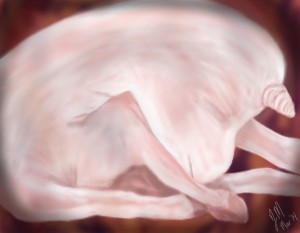An essay by Dr. Vadim Orlov, as provided by Ian Rose
Art by Justine McGreevy
I did it. It was me. We have all paid the price for my hubris and that of the fools who joined me. This is my confession.
I released the unicorn into our world.
We discovered its remains in a cave system in eastern Russia. The cave itself was only found a year before, revealed while digging the foundation for a new shopping center. Staff from the local museum knew immediately that they had something special, and when I was flown in from Moscow and first laid eyes on the massive cover stones blocking the cave entrance, it was the most exciting day of my professional life.
Nine layers of intricately carved stone had been laid to cap the tunnel, a level of technological effort never before seen in a site so old, but the cave itself, once revealed, was surprisingly free of any human symbols or characters. The only marks on the walls were deep gashes, as if someone had hacked at the stone repeatedly with a sword or axe.
Delving deeper, we found the beast.
At first, it looked to be nothing but bones, its flesh eaten away by millennia in the damp recesses of the cave. The skeleton was clearly equine, but larger by half than any extant species of horse. From its forehead rose a single spiraled horn, pure white and untouched by the ravages of so much time. Closer investigation revealed a small patch of meat hanging from one of its hind legs.
Naturally, we had our doubts. The entrance stones were impressive enough, but a unicorn skeleton was just too much for the skeptics. I counted myself among them. I ran every dating test twice, and they all came up with the same result: the creature had lived and died over 20,000 years ago.
The cloning idea came from a science blogger in Japan, and her audience enthusiastically spread it around the web. She even suggested that if we were willing to make the attempt, using the same techniques which had recently been used to resurrect the Tasmanian tiger and woolly mammoth, she would help raise the money.
Our crowdsourcing campaign reached its initial goal in 36 hours. By the time it was over, we had raised millions more than we needed. We had no choice but to try.
The cells in that small scrap of recovered meat proved to be remarkably intact. At every step of the process, we marveled at the ease and quickness of success. We had a viable egg and sperm in a matter of weeks, engineered from the DNA in that tiny sample. The mammoth had taken almost a year.
Inside the belly of a Clydesdale mare, we watched the creature grow. When the tiny nub of its horn appeared on an ultrasound scan, it became the most shared digital image of the year. It was a perfectly healthy developing foal, in every way a horse except for its size and its legendary ornament.

The foal was born on a sunny day in June, the day that everything changed.
To read the rest of this story, check out the Mad Scientist Journal: Spring 2014 collection.
Dr. Vadim Orlov was a distinguished professor of zoology at Moscow University before the fall. Despite a long career in paleontology and many important publications, he will unfortunately be best remembered for his participation in the events described above, and his organization of human survivors afterward. He had a wife and two adopted children in Moscow, whose whereabouts are still unknown.
Ian Rose lived on every coast that the United States has to offer, and had a few short stints inland, before settling in Oregon. He lives with his fiancee, her daughter, and a mischievous black cat. His work has recently appeared in New Myths and Cast of Wonders, and more of his writing can be found at http://ianwrites.com.
Justine McGreevy is a slowly recovering perfectionist, writer, and artist. She creates realities to make our own seem slightly less terrifying. Her work can be viewed at http://www.behance.net/Fickle_Muse and you can follow her on Twitter @Fickle_Muse.
Follow us online: